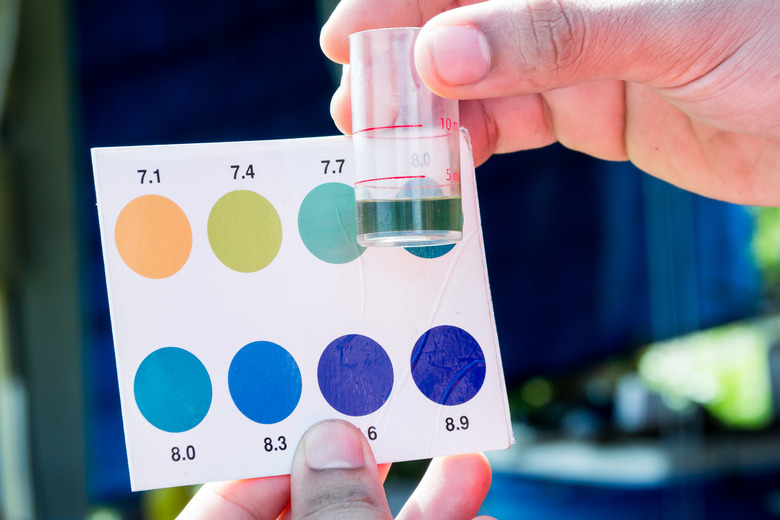How To Calculate Alkalinity As Concentration Of CaCO3
Pure water doesn't exist in nature. Even in artificial environments, the purity of water doesn't last much past the opening of the bottle. Water dissolves more substances than any other known liquid. In fact, most people find "pure" water tastes odd. Life depends on water's ability to dissolve many substances, and water's dissolved chemicals determine some of the critical physical conditions of ecosystems. Two important and interrelated water-related conditions are acidity and alkalinity.
TL;DR (Too Long; Didn't Read)
Use this equation to calculate the alkalinity in terms of CaCO3: Alk(mg/L CaCO3)=Alk(meq/L)x(1mmol CaCO3÷2meq)x(100.087mg CaCO3÷1mmol CaCO3)=(50044xBxCaxCF)÷Vs. The variables used are the volume of acid (B) used in the titration, the concentration of the acid (Ca), the volume of water in the sample (Vs) and a correction factor (CF), if necessary.
Importance of Alkalinity
Importance of Alkalinity
Alkalinity determines how water resists changes in pH, in particular resistance to becoming acidic. Higher alkalinity means higher resistance to changes in pH. Changes in pH can be devastating to the ecosystem. Many plants and aquatic animals require a very narrow pH range to survive. Even less pH-sensitive animals suffer if changes in pH impact the food chain. In addition to the natural ecosystem, alkalinity impacts wastewater systems and suitability of water for irrigation. Alkalinity, also referred to as water hardness, impacts home water systems by building mineral deposits in pipes and pans as well as increasing the amount of soap people use by inhibiting lather.
Units of Alkalinity
Units of Alkalinity
Alkalinity measures the amount of calcium, magnesium and other acid-moderating ions. Alkalinity may be reported in terms of calcium carbonate, CaCO3. Alkalinity is usually measured and reported in terms of parts per million (ppm) or grains per gallon.
Preparing for Testing
Preparing for Testing
The recommended method for determining alkalinity uses inflection point titration (IPT) with sulfuric acid solution. Even when using commercially available 0.01639N sulfuric acid solution, be sure to test the solution against a sodium carbonate standard. Different acid concentrations may be used, especially with lower alkalinities, but the acid must be compared to a standard.
Water samples need to represent the environmental conditions, so exposure to sunlight, dust, rain or other contaminants may alter test results. Over time, temperature changes may also affect the sample quality, so samples should be kept at the temperature of the original environment. For alkalinity tests, filter the water samples through a 0.45-µm membrane where the unit µm means micrometer, or micron. The micrometer equals 10-6 meter or one-millionth of a meter.
Most tests use a fifty milliliter (50mL) sample in a 100mL beaker, but for low alkalinity samples a larger sample of 100mL may be used.
Test Apparatus and Methodology
Test Apparatus and Methodology
The preferred testing method uses a glass buret, but a digital titrator may also be used. Be sure the buret is clean and dry so that the acid solution will not be diluted.
Use standard titration methodology with special care taken around pH 8.3 and pH 4.5. For finding alkalinity in terms of calcium carbonate, take particular care as the sample pH approaches pH 4.5.
Calculating Alkalinity
1. Formulas for Calculating Alkalinity
The formula for calculating alkalinity finds the ratio of acid to the bicarbonate equivalency point. The first equation shows the alkalinity in milliequivalents per liter.
Use this formula to find alkalinity:
Alk(meq/L)=[B(mL)xCa(meq/mL)xCF]÷[Vs(mL)x(1L÷1000mL)]=(1000xBxCaxCF)÷Vs
The following equation combines the alkalinity equation with the conversion factor to calculate the alkalinity in CaCO3:
Alk(mg/L CaCO3)=Alk(meq/L)x(1mmol CaCO3÷2meq)x(100.087mg CaCO3÷1mmol CaCO3)=(50044xBxCaxCF)÷Vs.
2. Determining Variables
Calculating alkalinity requires knowing:
Alk means alkalinity
B: The volume of acid used in the titration from the original pH to the equivalency point (near pH4.5) in milliliters.
Ca: The concentration of the sulfuric acid expressed as normality N or as milliequivalents per milliliter (meq/mL).
Vs: The volume of the sample in milliliters.
CF: A correction factor, if necessary. The correction factor for the Hach digital titrator cartridges equals 1.01; all other titration methods have a correction factor equal to 1.0.
3. Calculating Alkalinity
Assume the volume of acid (B) used equals 12 milliliters of acid, the acid's concentration (Ca) equals 0.01639meq/mL, and the water sample volume (Vs) equals 50mL of water. If performing the titration with a standard buret, the correction factor (CF) equals 1.0. To calculate the alkalinity, insert these values into the first equation. The calculation becomes:
Alk=(1000xBxCaxCF)÷Vs or Alk (meq/L)=[1000x12mLx0.01639(meq/mL)x1.0]÷50mL.
Solving for alkalinity yields: Alk(meq/L)=3.9 meq/mL.
4. Calculating Alkalinity as CaCO₃
To calculate alkalinity as calcium carbonate, use this formula to calculate the alkalinity in concentration of calcium carbonate (CaCO3). Insert the values into the formula to determine the alkalinity as CaCO3:
Alk(mg/L as CaCO3)=(50044xBxCaxCF)÷Vs.
Inserting the example values, the equation becomes:
Alk(mg/L as CaCO3)=[50044x12mLx0.01639meq/mLx1.0]÷50mL. Solving the equation yields Alk(mg/L as CaCO3)=196.8mg/L.
Interpreting Results
Interpreting Results
Milligrams per liter (mg/L) equals parts per million (ppm). Alkalinity is also known as water hardness. In general, water with a hardness less than 17.0 ppm is considered soft water. Water with hardness over 180 ppm is considered very hard water. In this example, the water sample has very high alkalinity.
Cite This Article
MLA
Blaettler, Karen G. "How To Calculate Alkalinity As Concentration Of CaCO3" sciencing.com, https://www.sciencing.com/calculate-alkalinity-caco-5328969/. 4 June 2018.
APA
Blaettler, Karen G. (2018, June 4). How To Calculate Alkalinity As Concentration Of CaCO3. sciencing.com. Retrieved from https://www.sciencing.com/calculate-alkalinity-caco-5328969/
Chicago
Blaettler, Karen G. How To Calculate Alkalinity As Concentration Of CaCO3 last modified March 24, 2022. https://www.sciencing.com/calculate-alkalinity-caco-5328969/
